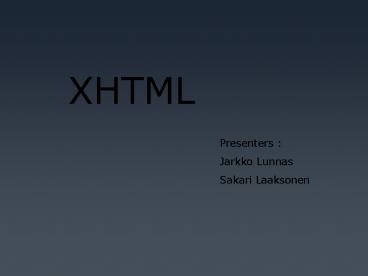XHTML - PowerPoint PPT Presentation
1 / 22
Title:
XHTML
Description:
NAME Cardboard Elvis /NAME /PRODUCT /PRODUCTS Components. Information content components ... The content management market is huge and growing day by day ... – PowerPoint PPT presentation
Number of Views:56
Avg rating:3.0/5.0
Title: XHTML
1
XHTML
Presenters Jarkko Lunnas Sakari Laaksonen
2
XHTML - Introduction
Contents
- INTRODUCTION
- XHTML 1.0
- Why XHTML?
- XHTML vs. HTML
- Declarations
- Differencies in declarations
- Validating XHTML
3
CMSs (in web) What are CMSs
What are CMSs ideal for?
- CMSs are for managing larger scale publications
which are hard to control and manage - Used for publishing same content in different
publications
4
CMSs (in web) What are CMSs
Categorizing CMSs
Enterprise Management Systems / EMSs Stores and
manages organizations e-publications,
documentation and Web content so that the
employee of the company can reuse the information
across different applications.
- Web Content Management Systems / WCM systems
- The main focus of the system is to publish
content in the Internet environment - The system repositories lie on web server
- Managed with browser-based tools
5
CMSs (in web) What are CMSs
Categorizing CMSs
Open source (free) Ez Publish
http//ez.no/ PHP-Nuke http//www.phpnuke.org/ Mam
bo server http//www.mamboserver.com/
Commercial CMSs Crasmanager http//www.crasmanage
r.fi Navigo CMS http//www.ch5finland.com
6
CMSs (in web) What are CMSs
- What CMS provides?
- Main purpose to provide solid control over the
content and publications, to be able to publish
same content in different publications - Role of CMS for clients makes possible to
maintain the sites without knowing actual
code-languages - For developers To provide a structured and easy
to use framework for further development
7
CMSs (in web) Principles and logical design
- Main principles
- Rendering format needs to be separated from the
actual content and metadata - Content needs to be separated to components and
stored in a hierarchial structure - Content managing is all about relating components
to each other
8
CMSs (in web) Principles and logical design
Components
ltPRODUCTSgt ltPRODUCTgt
ltIDgt11007lt/IDgt ltNAMEgtCardboard Cup
Sleevelt/NAMEgt ltPRICEgt00.02lt/PRICEgt
ltDESCRIPTIONgt Available in brown,
white, and green. lt/DESCRIPTIONgt
ltPICTUREgt/images/cupsleeve.jpglt/PICTUREgt
lt/PRODUCTgt ltPRODUCTgt
ltIDgt11008lt/IDgt ltNAMEgtCardboard
Elvislt/NAMEgt . .
lt/PRODUCTgtlt/PRODUCTSgt
Information content components All the content
needs to be separated into smaller chunks of
information.
9
CMSs (in web) Principles and logical design
Structuring Hierarchies (TOC) Indexes Cross
references Sequences
10
CMSs (in web) Principles and logical design
- Structuring
- Control the structure and you control the
content and its publications - CMS access structure
- Inside the CMS for management
- Outside for navigation
- Publication access structure
- Set of access structures that relate the parts
inside the publication and lets you know whats
inside the publication
11
CMSs (in web) Principles and logical design
- Templates
- Basic templates shouldnt require any programming
skills - Template process
- 1. create a standard page, that all the other
pages follow - 2. replace all the particulars (that will differ
between pages) with placeholders - 3. template processor replaces the placeholders
with the particulars they address per page - - own syntax can be added as well
ltHTMLgt ltHEADgtInsert Titlelt/HEADgt
ltBODYgtInsert Bodylt/BODYgtlt/HTMLgt
12
CMSs (in web) Principles and logical design
- Templates
- Main template types
- Page templates
- Navigation templates
- Component templates
13
CMSs (in web) Principles and logical design
Programming, use of mark-up languages and
databases Open programming standards
Object-oriented programming Programmed
components use from and stores the data (the
given attributes) to a relational database or to
an XML file
14
CMSs (in web) CMS areas and workflow principles
Repository the heart of the management system
- Storage for components from where they can be
continually managed to increase the quality of
their metadata or content - Content databases
- Content databases such as relational databases
and XML Object databases, not necessarily
mutually exclusive - Content media files
- Apart from a database as separate files
- Control and configuration files
- Templates, metadata lists indexes, scripts,
workflow rules etc.
15
CMSs (in web) CMS areas and workflow principles
- Main workphases
- Collect
- Manage
- Publish
16
CMSs (in web) CMS areas and workflow principles
- Workflow system
- Goal is to make complex tasks as easy as possible
for the user to carry out - layered functionality
- triggering
- archiving
- backup processes
- connection management processes
17
CMSs (in web) CMS areas and workflow principles
- The publishing system
- Repository -gt Content -gt Templates -gt
Publications - Web publication process
- Loads a template.
- Pass any parameters that came along the request
- Execute code in template to produce the finished
page - Pass finished page to web server for display to
users browser
18
CMSs (in web) CMS areas and workflow principles
- Administration system
- sets parameters and takes care of the structure
of CMS - includes staff configuration, metatorial and
system configuration
19
CMSs (in web) CMS demonstration
CMS Demonstration
- Crasmanager 4.1
20
CMSs (in web) Additional business values
Additional business values through CMSs
- Hosting deals
- Efficient re-use of resources
- More focused component and system development
- Savings in providing correct up-to-date info
21
CMSs (in web) Future scopes
Future scopes
- The content management market is huge and
growing day by day - CMS features are expected to become more
standardized - CMS field is maturing all the time to have
higher level of consistency, repeatability and
professionalism - Content managing will extend its scope more and
more to hypermedia, software engineering,
marketing and business process design and such
22
CMSs (in web) Sources
Sources
- Books
- Content Management Bible, by Bob Boiko
- Companies
- Crasman Company Ltd.
- Internet
- Content Management Tutorial _at_ http//chalaki.com































